
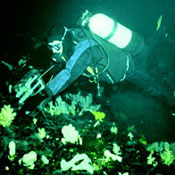 Researcher Marc Slattery samples water-borne chemicals with antibiotic properties from soft corals in Antarctica.
Researcher Marc Slattery samples water-borne chemicals with antibiotic properties from soft corals in Antarctica.
In the past 10 years, the UM pharmacognosy professor has visited more than 20 countries and dived in every ocean on the globe. He’s been to both the North and the South poles. In June, he’d just returned from New Zealand before jetting off again to Italy. Later in the summer, he was off to the Bahamas.
As director of the university’s Ocean Biotechnology Center and Repository, or OBCR, Slattery’s work mandates that he escape to exotic locales in the Virgin Islands and the South Pacific on a regular basis. Far from vacationing, however, Slattery spends his time in some of the most beautiful places on earth in diligent pursuit of marine biochemicals that may provide the basis for a lifesaving anti-cancer drug or new antibiotic.
That pursuit is sort of a high-tech scavenger hunt. Slattery and his team gather algae, coral, seagrasses, small sea animals, sponges and other marine life from around the world. They bring small samples back to UM, where researchers at the National Center for Natural Products Research analyze them, trying to isolate any chemical compounds that might have medicinal properties.
So far, about 10 percent of the 3,000 samples the team has gathered have shown promising biomedical activity. While that might not sound like much, consider this: Of the 20,000 land-based plants that NCNPR scientists have analyzed, only one-half of 1 percent are considered promising.
There’s a reason for that discrepancy, Slattery says.
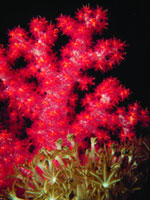 Soft-bodied invertebrates, like these soft corals, are a ‘treasure chest’ of chemicals that have potential as new pharmaceuticals.
Soft-bodied invertebrates, like these soft corals, are a ‘treasure chest’ of chemicals that have potential as new pharmaceuticals.
“Unusual chemical compounds that are a part of the marine environment just aren’t found in the terrestrial environment,” he explains. “We’re getting really significant differences in terms of chemical structure than anything you find in land-based plants.”
The better success rate for marine organisms as medicinal compounds—compared with their terrestrial cousins—has a simple biological explanation, Slattery says. In order to survive a more hostile, bacteria-laden environment, marine creatures have evolved with their own defense systems.
“If you’re attached to the bottom of the ocean, you can’t run away from predators, and you can’t migrate away from disease,” he says. “Marine organisms have to develop chemical defense mechanisms.”
A mollusk’s or sponge’s chemical defense mechanism may provide a defense mechanism for humans as well, in the form of new antibiotics or anti-cancer drugs, thanks to research performed by scientists at the OBCR in collaboration with the natural products center.
The type of research Slattery and his team are doing has been around for only the past 20 years or so—which is, coincidentally, about the same amount of time it generally takes for a chemical compound to go from a field sample to a drug on pharmacists’ shelves.
“We’re just now starting to see movement from the beginning of the research,” Slattery says. “One painkiller is about to be released to market that began as a sample from a sea snail.”
That painkiller, he says, is purported to be 10,000 times as powerful as morphine without the narcotic’s addictive side effects.
Another compound discovered by fellow UM pharmacognosy researcher Mark Hamann in a Hawaiian sea slug is in clinical trials as an anti-cancer agent.
Help from His Friends
The OBCR is just one of three research centers sheltered by the National Institute for Undersea Science and Technology, or NIUST, which teams scientists from The University of Mississippi and the University of Southern Mississippi to work together in multidisciplinary undersea research. Established in 2002 through a partnership with the National Oceanic and Atmospheric Administration, NIUST includes scientists in fields ranging from biology to engineering. They might study sea plants and animals, hunt for natural gas hydrates on the ocean floor or develop new technologies to explore the seafloor more quickly and efficiently.
In addition to ocean biotechnology, NIUST oversees the Seabed Technology Research Center, headed by UM geology professor Bob Woolsey, and the Undersea Vehicles Technology Center, directed by Vernon Asper of USM.
Ray Highsmith, a marine scientist who is also director of UM’s Field Station, became executive director of NIUST in 2005. Highsmith came to UM from the University of Alaska at Fairbanks, where he was director of another undersea research center funded by NOAA.
The NIUST executive director must keep tabs on all its research— whether biological, geological or technological.
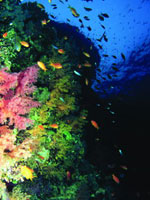 Biodiversity of coral reefs is equal to the rain forests; competition for space and food has resulted in the evolution of novel defensive chemicals that are being studied as drugs from the sea.
Biodiversity of coral reefs is equal to the rain forests; competition for space and food has resulted in the evolution of novel defensive chemicals that are being studied as drugs from the sea.
“I’m the umbrella,” Highsmith says. “My job is to keep them acting like a single unit; to be a comfortable home able to handle all their individual parts.”
As a national research institute, NIUST also awards research grants to scientists from across the country. But the focus on internal research—and developing relationships among its three centers—makes NIUST unique.
At first glance, the three centers don’t seem to have much in common, but many opportunities for collaboration and complementary research exist.
Woolsey’s seabed group focuses on the study of undersea natural gas hydrates, a solid form of gas and water formed under high-pressure conditions in deep ocean waters. The group studies how and why hydrates form and how they affect the stability of the seafloor or the atmosphere.
The seabed group has established a seafloor monitoring station in the Gulf of Mexico, 100 miles off the coast of Mississippi. The station should be up and running this summer, Highsmith says.
Meanwhile, Asper’s undersea vehicles center is developing robotic submarines that can travel for months gathering information about the seafloor. The center has acquired one such vessel that other NIUST scientists will be able to use next year, Asper says.
The vehicle, called an autonomous undersea vehicle, or AUV, can work in water up to 2,000 meters deep, using acoustic mapping systems to create a highly detailed and accurate map of the seafloor topography, Asper says. But additional sensors can be added to detect methane, which could help the seabed researchers pinpoint hydrate deposits, and information gathered on seabed conditions can be used by Slattery’s biotech group.
The opportunities for collaboration benefit not just the researchers themselves but also the entire state and region, Asper says.
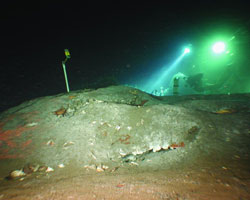 Hydrate mound with manned submersible in background
Hydrate mound with manned submersible in background
“I think it’s absolutely fantastic,” he says. “They have expertise that we need and vice versa. We’re getting over the football rivalry mentality and recognizing that we need to pool our tremendous resources within our state to be more efficient and do good science.”
Slattery and Woolsey also have collaborated in a much lower-tech capacity recently. They “boatpooled.”
On Woolsey’s recent trips to assess methane hydrates in the Gulf of Mexico, Slattery’s ocean biotechnology group shared the research vessel. The seabed group tested its vertical sensor array in the water column, studying the gases vented to the surface by a hydrate deposit. Woolsey’s group used a submarine to study the seafloor, and then Slattery’s group used the submarine, which was outfitted with a claw, to collect samples that are extremely promising as potential medicinal agents.
“The benefit of NIUST is that we can leverage off what … are doing,” Slattery says. “We were able to share $300,000 in equipment, and both do our research. NIUST gives us a larger operating network and capability of doing things.”
Another benefit of working so closely with engineers is their ability to build things to exacting specifications—something marine biologists aren’t exactly known for doing.
“If we need to engineer something to grow bacteria under high-pressure conditions, they’re going to be able to help us out,” Slattery says.
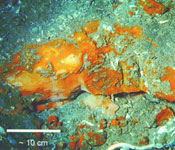 Hydrate outcrop at observatory site
Hydrate outcrop at observatory site
Bricks, Mortar and Bioassays
When not sailing and diving, Slattery and his group subject their samples to a battery of tests and screenings at the UM natural products center, which provides far more than a bricks-and-mortar home for OBCR.
“We leverage the facilities and the expertise of the natural products center,” Slattery says. “We’re not trying to reinvent the wheel—we use their databases and their bioassays to analyze our samples.”
In 10 days of diving in Guam or Saipan, for instance, Slattery’s group might bring back 300 samples for analysis.
“A survey of that magnitude would mean the people in our lab would work nonstop for a year,” Slattery says. “Thanks to the resources here at the natural products center, we’re able to turn out results in a month to two-month timetable. The research moves at a much faster pace.”
Another 15 to 20 years and $1 billion in additional research and clinical trials still stand between consumers and the potential anti-cancer chemical compounds found in that Hawaiian sea slug. So in a way, Slattery’s group’s work has an element of “hurry up and wait.”
“Our hope, of course, is that, down the road, some of these products will make it to the point where they’ll be licensed,” Slattery says. “But we’re in this for the science. We want to understand more about our world and hopefully help some people in the process.”